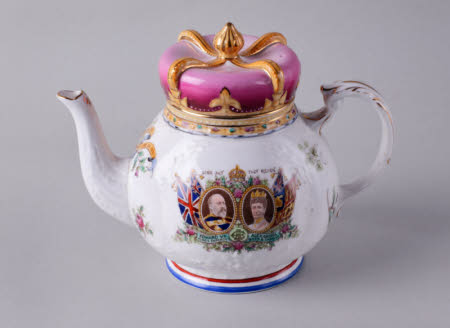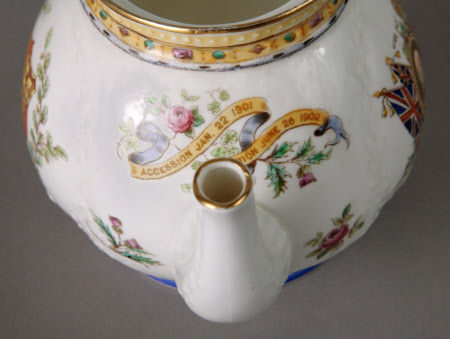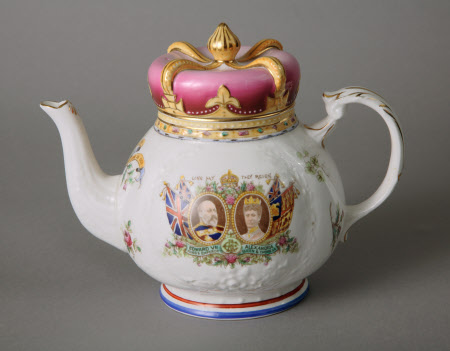Teapot to commemorate the coronation of King Edward VII (1841–1910) and Queen Alexandra (1844-1925)
Samuel Radford Ltd
Category
Ceramics
Date
1902
Materials
bone china, transfer printed, over glaze enamels
Measurements
190 mm (Height) x 230 mm (Depth)
Place of origin
Staffordshire
Order this imageCollection
Hill Top, Cumbria
NT 641566
Summary
Teapot, Samuel Radford Ltd, Fenton, Stoke-on-Trent, ca 1902. Made to commemorate the coronation of King Edward VII and Queen Alexandra. Above the spout is inscribed 'Accession Jan. 22 1901 / Coronation June 26 1902'. One side of teapot printed with portraits of the King and Queen surrounded by moulded floral wreaths, the reverse with the Royal coat of arms of the United Kingdom surrounded by a laurel wreath. The cover is in the form of a large pink crown. No mark.
Full description
This teapot is part of the collection at Hill Top. Beatrix Potter purchased this farmhouse in the Lake District village of Near Sawrey in 1905, using the profits from her books. After her marriage to William Heelis in 1913, Beatrix relocated permanently to Sawrey. The couple made nearby Castle Cottage their home, but Beatrix spent as much time as she could at Hill Top. As well as a space for work and creativity – and the location for many of her famous tales – it became an intensely personal sanctuary for her. Beatrix knew exactly how she would decorate Hill Top and she arranged its interiors carefully and deliberately. She wrote: ‘I would have old furniture…it is not as expensive as modern furniture, and incomparably handsomer…’ Once she had renovated the farmhouse, she filled it with examples of local furniture and treasured heirlooms, like her grandmother’s warming pan and a set of plates decorated with designs by her father. A number of objects at Hill Top are recognisable in illustrations for Potter’s tales. This teapot, with its distinctive crown-shaped cover, is shown in several images in The Tale of the Pie and the Patty Pan, published in 1905. While the overall form of the object is faithfully reproduced, Potter simplifies its decoration to fit the scale and composition of the illustrations. A watercolour in the collection shows the characters Ribby and Duchess – a cat and a Pomeranian dog – sitting together with the pie that forms the focus of the story (NT243465). The table is spread with pink and white ceramics, including this teapot. Although unmarked, the teapot is known to have been made by the Staffordshire manufacturer, Samuel Radford Ltd, which was based on the High Street in Fenton, Stoke-on-Trent. It commemorates the coronation of King Edward VII and Queen Alexandra in June 1902 – three years before Potter published The Tale of the Pie and the Patty Pan. A marked example of identical form but with variation in the decoration is in the collection at the Potteries Museum (accession number 818P1963). One side of the teapot is printed with portraits of the King Edward and Queen Alexandra, with a banner reading ‘LONG MAY THEY REIGN’ above and others giving their official titles beneath. The titles of Emperor and Empress of India were used by British monarchs to signify their role as head of state during the period of British rule in India. On the reverse is the Royal coat of arms of the United Kingdom surrounded by a laurel wreath. The lithographic decoration was produced by a specialist company and would have been bought in by Radford for decorating wares. As these were ‘open stock’ patterns, the same commemorative designs often appear on ceramics made by different companies. Many commemorative ceramics were produced as popular souvenirs of the coronation including plates, mugs, jugs, plaques, and tea and coffee sets.
Provenance
From Troutbeck Park.
Makers and roles
Samuel Radford Ltd, china manufacturer
References
Hallinan 1995: L. Hallinan, British Commemoratives: Royalty, Politics, War and Sport Suffolk: Antique Collectors’ Club, 1995 Conroy 2023: Rachel Conroy, ‘A love of ‘old china, especially earthenware’: ceramics at Beatrix Potter’s Hill Top and in her ‘little books’, Transactions of the English Ceramic Circle (Volume 34, 2023), 95-112




